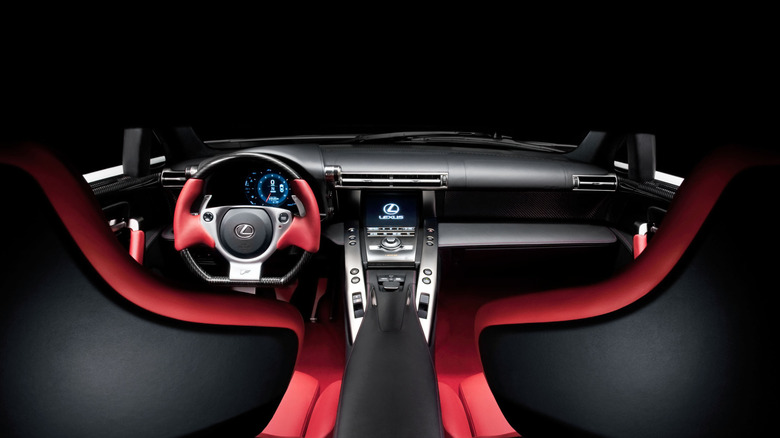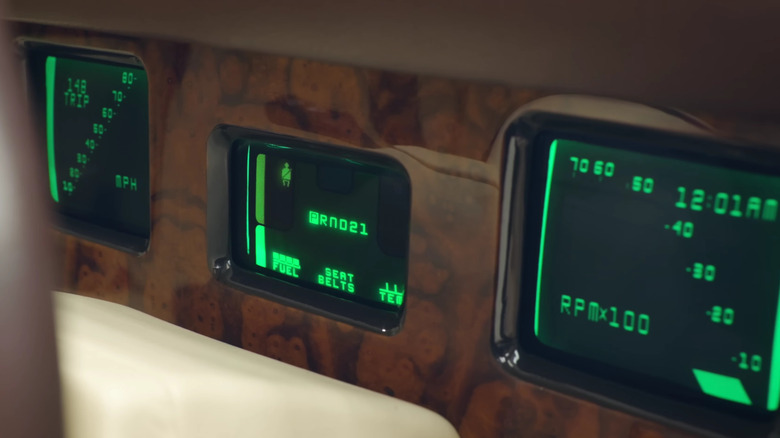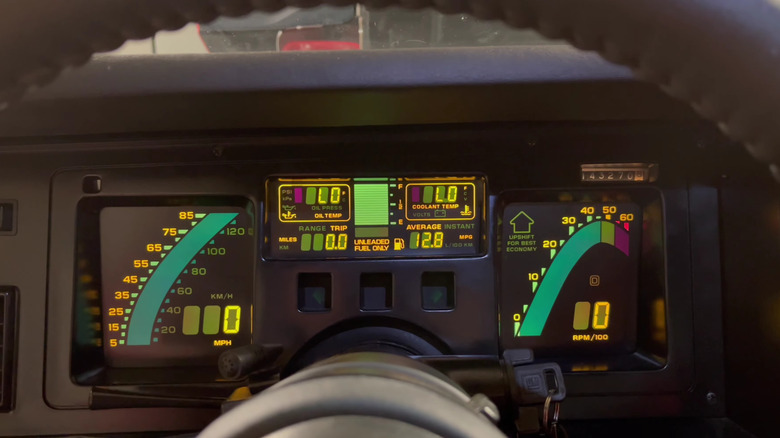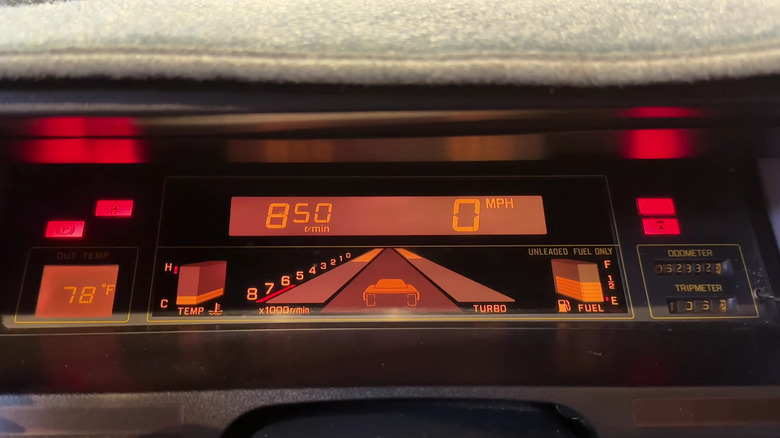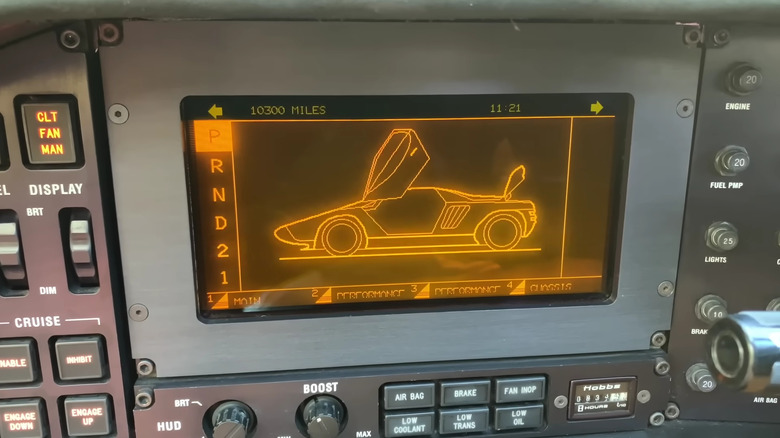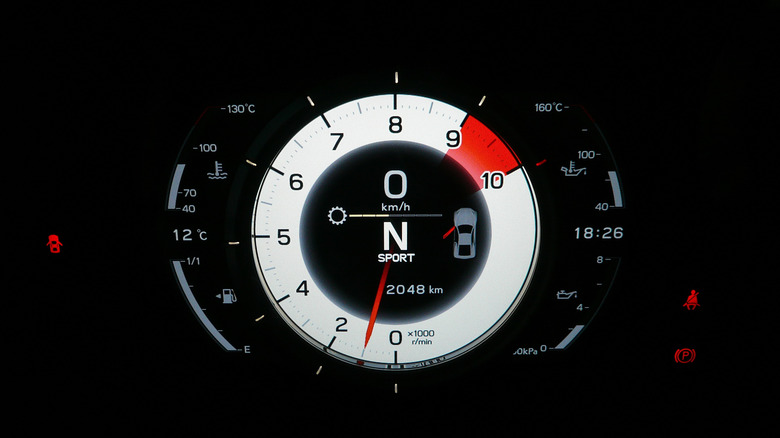5 Cars With The Coolest Dashboards Displays
For better or worse, displays are dominating car dashboards today. It's even turned into a contest between automakers. Mercedes-Benz's Hyperscreen puts three massive screens in a 56-inch (diagonal) curved piece of glass. GM's application in the Cadillac Escalade IQ? Fifty-five inches.
Yes, they look hi-tech, but not exactly cool. See, screens are super cheap today. Want proof? The $225 Samsung Galaxy A26 smartphone has a massive 6.7-inch, 120Hz Super AMOLED display. In that sense, utilizing ever-larger displays seems like a lazy move. Instead of designing a unique dashboard, automakers now cram as much screen real estate as possible into cabins to wow buyers.
But this wasn't always the case. Dashboard displays have been present in the automotive landscape for quite some time, and not for the reasons they are used today. Heck, they were present when GPS tracking wasn't even a thing. Why? Because they were different. Unique. They tried to convey information in a completely different manner than analog dials. And in this piece, we'll highlight five cars we think have the coolest dashboard displays. Coolness isn't exactly measurable, but we are confident that these sci-fi designs will capture your attention, maybe even thrill you. Time to take a closer peek!
Aston Martin Lagonda Series 2 & Series 3 (1974 to 1990)
The Lagonda Series 2 is arguably the most popular automotive flop of all time, and Aston Martin's most expensive failure. Notoriously unreliable, with most of its features not working even at the factory, Aston Martin's perspective-shifting car had a hard time finding buyers. It was so bad that it almost killed Aston Martin. Notably, the automaker spent four times the original development budget, with no sales to cover the expenses.
Still, it's hard not to wonder what could've been if Aston Martin had solved the reliability issues. The Lagonda just hits differently. Its wedge-shaped body, borrowed from 1970s supercars, looks sleek and menacing. Futuristic, even. It must've been shocking when the first prototype appeared in 1976. The specs were also impressive — the V8-powered Lagonda could reach 148 mph.
But even that couldn't prepare the already amazed onlookers for what awaited inside. With a huge, fully digital instrument panel, luxurious yet minimalistic flat surfaces, and touch-sensitive buttons, the Lagonda Series 2 looked like the personal vehicle of Captain James T. Kirk. It was sci-fi cool. It got even better with the Lagonda Series 3 CRT dash, which looked straight out of a fighter jet, and the subsequent minimalistic design with a speedo and rev counter.
But that was only design-wise, because almost nothing worked. The touch-sensitive buttons were often unresponsive. The same went for the digital dashboard. Perhaps the tech was too far ahead of its time, but one thing is certain — the feature that should've launched it into the stratosphere ended up killing the Lagonda.
Chevrolet Corvette C4 (1984 to 1996)
The C4 was perhaps the most revolutionary Vette if you don't count the latest mid-engine C8. Gone was the swoopy styling of the C3, and in its place, a sharper, more muscular, sleeker appearance. The Corvette went macho. Forward-looking. Still, it kept the predecessor's sophisticated looks. The proportions were different, too, with the C4 measuring 9 inches shorter. Unsurprisingly, we ranked it among the coolest cars with pop-up headlights ever built.
More than that, though, it was a completely new car that shared almost nothing with its predecessor. It had an advanced unibody frame made from galvanized steel and fiberglass panels. An upgraded, five-link rear Zora suspension. A four-speed transmission with overdrive for each gear except the first. Oh, and later during its production life, the Corvette C4 ZR-1 put Ferrari and Porsche on notice with the Lotus-designed 5.7-liter V8. The advanced, 32-valve engine produced 375 hp and 370 lb-ft of torque. 0-60: 4.5 seconds. Top speed: 175 mph.
The best part? It also felt futuristic behind the wheel. The C4 was one of the early cars with a digital gauge cluster, and boy, it looked cool. Like you were sitting in a spaceship — not a good old American V8 sports car. The fully digital LCD speedo illuminated an ascending curve as you accelerated, just for show, because it was also accompanied by digits that showed the exact speed. The rev counter was perhaps even cooler, as it was made to look like an engine's horsepower curve. The orange/green/red color scheme increased the coolness factor to eleven.
Subaru XT Turbo (1985 to 1991)
Chevy wasn't the only automaker diving deep into the digital era during the 1980s. Subaru was quick to follow with the XT Turbo with a video-game-like, uber-cool design. In this application, Subaru's designers placed an outline of the angular, futuristic XT Turbo on the dashboard, nestled between the rev counter and turbo boost indicator running far into the horizon. Accelerating with the XT Turbo, then, made it look like the car on the dashboard was moving. The 3D temperature and fuel gauges were also a nice touch.
But the coolness of the XT Turbo's interior wasn't limited to the instrument cluster. The shifter, for instance, also followed the video-game path with a joystick-like appearance. Most of the controls were positioned near the steering wheel. All that was nestled in a driver-oriented cockpit with fighter-jet-like vibes.
The interior suits the angular XT Turbo quite perfectly. Subaru's 4WD sports car looks a bit silly from some angles, but you can't deny its uniqueness — and aero-cheating properties. When introduced, with a drag coefficient of 0.29 Cd, the XT Turbo was the most slippery car on sale in the U.S.
The engine was perhaps the lamest part of the XT Turbo. The 1.8-liter turbocharged boxer produced just 111 hp and couldn't get you to 60 in under 10 seconds. Still, the Subaru XT turned into a better sports car with the introduction of the 2.7-liter flat-six later on, good for 145 hp. Some XT6s were even equipped with height-adjustable air suspension, but unfortunately used analog dials instead of the Turbo's cool digital dashboard.
Vector W8 (1989 to 1993)
Would you say the Lamborghini Countach is one of the most futuristic-looking supercars? Well, it looked downright ancient when the Vector W8 arrived. The sharp, angular wedge shape, flat and chiseled bodywork, and wraparound windshield made it look like a stealth bomber for the road, but with cyberpunk flair. The construction was science fiction, too. Vector founder and designer Gerald Wiegert went for a bonded aluminum monocoque, carbon, and Kevlar, all joined together using 5,000 aircraft-grade rivets.
The cyberpunk-like aesthetic was even more evident inside. Again inspired by fighter jets, with buttons galore and an information-dense LCD screen to the left of the steering wheel, the W8's digital dash is as cool as you can get in a car. The screen showed an outline of the supercar but also had a menu structure where you could change different parameters, similar to modern infotainment systems.
But this American stunner didn't only look like it came from the future — it had the performance to match. Well, kind of. See, like the Aston Martin Lagonda, the Vector W8 was also one of the most expensive flops of all time. Yes, on paper, it was by far the most impressive four-wheel machine in 1989, packing a 6.0-liter twin-turbo V8 with 625 hp and 630 lb-ft of torque. The three-speed automatic was a bit strange, but even then, the W8 sprinted to 60 in 3.8 seconds and had a theoretical top speed of 218 mph. Still, it was notoriously unfinished, with numerous issues, including engine overheating, transmission failures, and even the boot floor carpeting melting on André Agassi's own W8.
Lexus LFA (2010 to 2012)
The Lexus LFA is one of the mythical supercars of the modern era. It endured significant development challenges, with Lexus famously scrapping the initial aluminum construction for a lighter, stiffer carbon fiber alternative. But after 10 years of continuously honing every detail of the car, Lexus produced one of the most exquisite four-wheel machines to ever grace the roads.
There is almost no component in the LFA that isn't exotic. Lexus even famously developed a special carbon loom to weave three-dimensional carbon fiber components. The engine is also the stuff of automotive dreams. Perhaps the best-sounding V10 engine ever made, the 1LR-GUE was co-developed with Yamaha, including its acoustical instrument engineers, to make it sound as dramatic as possible.
The 4.8-liter naturally aspirated V10 wasn't just about the sound, though. It was an engineering marvel, with a footprint as small as a V8 and as light as a V6. It had 10 individual throttle bodies, titanium alloy conrods, forged pistons, and a lightened crankshaft. All these worked in unison to extract up to 563 hp in the Nürburgring Edition and create an ear-piercing 9,000-rpm redline.
The LFA's exclusivity is only reinforced once you step inside the lavish cabin. Each part, again, was meticulously designed to feel special and unique: milled aluminum, magnesium, carbon fiber, high-quality leather. At the center of it all was perhaps the coolest full-color digital dashboard display ever made. Lexus motorized the central part so it could move sideways, revealing the sub-menus. Of course, the graphics also changed with each driving mode. It all just amplified the theatrics, helping the LFA reach its legendary status.
